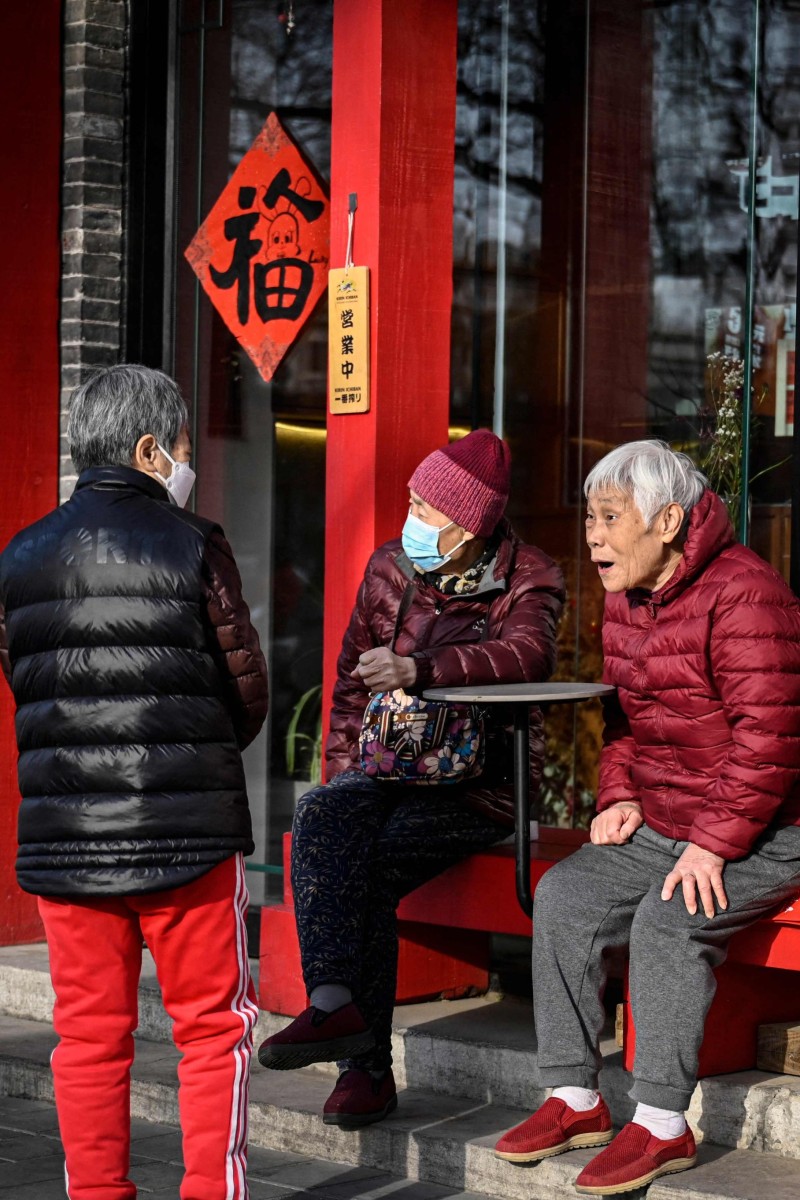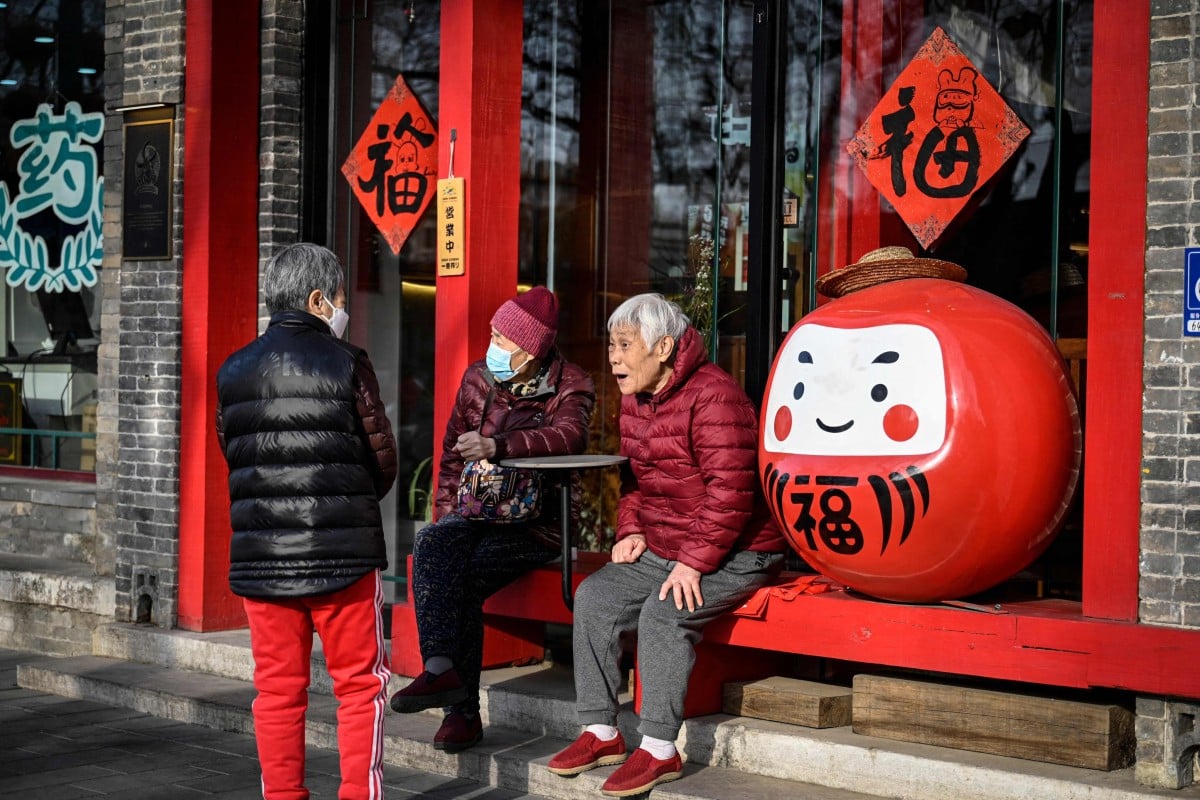
Deep Dive: China raises retirement ages as birth rate drops and ageing population grows
Country’s pension scheme is at risk as more people leave the workforce than enter.
 China recently announced it would raise the retirement ages as the country grapples with a looming demographic crisis and an older population. Photo: AFP
China recently announced it would raise the retirement ages as the country grapples with a looming demographic crisis and an older population. Photo: AFPDeep Dive delves into hot issues in Hong Kong and mainland China. Our easy-to-read articles provide context to grasp what’s happening, while our questions help you craft informed responses. Check sample answers at the end of the page.
News: China raises retirement age as it battles economic slump
-
Country’s top legislative body announced the move as a way to deal with its ageing population of workers
-
More people are set to retire than to enter the workforce, putting China’s pension scheme at risk
China will raise its retirement age as it battles an economic slump and pressure from an ageing population.
The retirement age for men will rise from 60 to 63 and for female office workers from 55 to 58, as decided by the Standing Committee of the National People’s Congress, the country’s top legislative body.
The biggest increase affects female blue-collar workers. Before, they could retire at age 50. Now, they have to wait until they reach the age of 55.
The previous retirement ages were well below those in most developed economies. In Japan, people can begin receiving pensions at 65, while in South Korea, the pension age is 63.
Last year, 21.1 per cent of China’s population was aged 60 or above. According to the Economist Intelligence Unit, that number could rise to 32.7 per cent by 2035.
Xinhua, China’s state news agency, said the changes will take effect from January 1, 2025.
The move was necessary, said Wang Xiaoping, minister of human resources and social security. She said the original retirement rules were devised in the 1950s, and China’s economic, social and demographic structure has changed over the years.
How China’s urban-rural divide affects students and hurts the economy
The country’s development coincided with families having fewer children and decades of birth restrictions under the former one-child policy. Now, China is stuck with a growing senior population and fewer young people.
“The new plan can help us better use human resources, effectively increase our labour force, and satisfy people’s diverse needs for more work or private lives,” she said.
Huang Wenzheng, director of a Beijing-based private think tank focused on demographic and public policy analysis, said the new changes were in line with observers’ expectations.
“This is mainly because China’s pension pool is drying up. As birth rates fall and life expectancy increases, the proportion of elderly is also increasing, which means the working population, or those paying into the pension pool, is becoming less and less,” he said.
The Chinese Academy of Social Sciences has warned that, based on current trends, the pension system will run out of money by 2035. It also said more people are set to retire than enter the workforce.
Huang said the new policy might affect young people’s employment and their willingness to have children. Many choose to have their retired parents help raise their children, and delayed retirement might stand in the way.
Question prompts
1. Which of the following statements are true based on News?
(1) The new retirement age for female office workers is 55.
(2) The current retirement ages were set when poverty was more common and before life expectancies rose.
(3) Projections show that the pension system will run out of money in 11 years.
(4) The one-child policy helped balance China’s ageing population.
A. (1), (2) only
B. (1), (3), only
C. (2), (3) only
D. (3), (4) only
2. According to News, why was there a need to raise the retirement age in China?
3. Based on Huang’s analysis, what role do young people play in the country’s pension schemes and the new retirement age?
Cartoon
Question prompts
1. What does the cartoon depict about China’s new retirement policy?
2. Based on News and the cartoon, what effect could a higher retirement age have in China?
Issue: Young people feel the brunt of China’s new retirement ages
-
Announcement has triggered a wave of uncertainty as people examine their spending and saving habits
-
Debates over pensions has arisen, with some calling private and government schemes unequal
The decision to raise China’s retirement age from next year has triggered a wave of reactions nationwide.
With the news fuelling uncertainty about what the move means for their retirement plans, some are rethinking their saving and spending habits, weighing such financial considerations against the prospect of working longer. Meanwhile, the overall feeling reflects a growing sense of unease about financial security in the face of extended careers and future economic shifts.
The news was hard to take for Clytie Chen, 26, who lost her job in July and decided to move back to Nanjing, her hometown.
“Who knows if I will lose my job again when I’m 35,” Chen said. “And when I’m about to retire at 60, they could turn around and tell me that I can only retire when I’m 65 or 70. I don’t know when I’ll be able to retire.”
She also feels that pension schemes are unequal, saying civil servants and workers at state-owned enterprises have received better pension schemes than private sector employees.
Chen had a high-pressure job at a carmaker and said more than 30 per cent of her income went on tax and pension payments. Given the high cost of living, there was little opportunity to save money.
“[Meanwhile] my father, who was a civil servant, is receiving a pension that is much higher than what I was earning with so much effort each month,” she said.
Joe Zhou, a 35-year-old analyst in Beijing, had a different perspective:
“There’s an emotional impact, but it feels like the government is just testing the waters. Even with the new retirement age, it’s still earlier compared with severely ageing countries,” he said.
“For people my age, there are too many immediate concerns to deal with. Overall though, pensions are too small to rely on. And without enough money, it doesn’t matter when you retire – you just can’t afford to.”
However, Zhou said he may start contributing less – or stop contributing entirely – to his voluntary private pensions.
“I was afraid that the pensions wouldn’t be enough, but now I am less worried, as the gap between the retirement age and life expectancy has narrowed by three years.”
He Yunbin, a 43-year-old car dealer in Zhejiang province, said that while the recent news has not affected his spending and savings, his outlook on the future has changed significantly.
“It’s about people’s trust in the government and concerns over the protection of their own interests,” he said.
“I will save more … no one knows what changes the future might bring,” said Zhu Dongxia, a 29-year-old research assistant in Beijing. “You just have to hold on to as much as you can. After all, it takes time to receive a pension, and with the current economic situation, people might be more inclined to save as a buffer against risks rather than spend.”
Question prompts
1. Which of the following statements are true based on Issue?
(1) Chen’s father gets more money from his pension than Chen did at work.
(2) Zhou may stop contributing to his voluntary private pensions because of the new retirement ages.
(3) Around 20 per cent of Chen’s income went to tax and pension payments.
(4) Zhou was frustrated that the new retirement age is later than that of other ageing countries.
A. (1), (2) only
B. (2), (3) only
C. (1), (4) only
D. (3), (4) only
2. Based on the information in Issue, what are TWO ways the new retirement age and China’s pension schemes impact workers?
3. According to Issue, how are people reacting to the new retirement age and why?
Graph
Question prompts
1. Identify and explain TWO trends depicted in this graph.
2. Based on News, Issue and your own knowledge, what are the wider implications of these trends?
Glossary
blue-collar workers: people who work in manual labour or skilled trades. Blue-collar jobs include electricians, plumbers, factory workers, construction workers, and truck drivers. Although they often do not require a university degree, they can be very tough and physical.
pensions: a regular sum of money paid to people who have retired, usually from the government
one-child policy: a government policy in China from 1980 to 2015 aimed at keeping the country’s population from rising too quickly. This policy told families they could only have one child. In 2016, the country raised the limit to two children. Beijing announced at the end of May 2021 that it would allow each couple to have three children.
life expectancy: the average age a person in a specific population is likely to reach before death. Life expectancies are rising as the world develops.
financial security: having enough money and other resources to support yourself
private sector: parts of the economy not owned and operated by the government. Rather, these businesses are run by private groups, usually for profit.
civil servant: those who work for the national or local government and are not part of the military.
Sample answers
News
-
C
-
The retirement age was established decades ago when life expectancy was shorter, and there was more poverty and scarcity. Now that life expectancy continues to rise, this means that people will spend more years not working. Moreover, the one-child policy has led to stagnant population growth and potentially a population decline. This means there aren’t enough workers to replace the older ones who are retiring, and more people are taking from the pension scheme than paying into it.
-
Young people pay into the pension pool, but it is drying up because there are more elderly people drawing from it than young workers paying into it. This puts people who depend on pensions at risk and raises questions about whether the scheme will even benefit young workers when they eventually retire. Therefore, instead of fixing the pension scheme, he thinks that government policies should focus on balancing the population as a whole and raising the birth rate. Unfortunately, as Huang points out, fewer people are having children and the number may even continue to drop now that their parents have to work longer and cannot help raise a child.
Cartoon
-
This cartoon shows a middle-aged, likely white-collar man running to reach “retirement benefits.” The sign for the benefits has been moved from the 60 mark to the 65 mark. This represents the increase in retirement age and shows how people have to “run” longer to reach it.
-
A higher retirement age could make people feel financially burdened from a young age because they have to save more to plan for their future. Older individuals may also feel upset and stressed because many were likely planning to retire soon, but now they will be forced to work several more years.
Issue
-
A
-
Young people may be more worried about the rise in the retirement age, as now they need to work and save for longer. They may also be concerned about whether the pension scheme will have enough money once it is time for them to retire. In addition, workers contribute a significant percentage of their pay to pensions, and it may seem unfair for people like civil servants to earn more through their monthly pension payment than workers do in their regular paycheques.
-
Young people are bearing the brunt of these changes and seem more worried, while older people appear far less concerned with the impact of the change. Zhou referenced having to reduce the amount of money he puts into his voluntary private pensions, and Chen expressed frustration about money and savings and the prospect of retiring. Conversely, He and Wang, both older people, said they would not change their spending and saving habits. Zhou was more concerned with the emotional impact of the change - alluding to a dampened morale - but still felt that people his age had too many other things to worry about than to get concerned about the future. Chen, however, was feeling resentment towards unequal pension plans, particularly in the face of her job loss. In general, the sentiment is that young people will have to shift their spending and saving habits and be more financially conscientious.
Graph
-
The graph shows a significant increase in the number of Chinese people aged 65 or older between 1990 and 2024. It also projects that from 2024 to 2032, the percentage of elderly people will rise from 15 per cent to 20 per cent of China’s total population. Additionally, the graph shows that the total population steadily increased until recently, but now it has levelled off and may even begin to decrease. (accept all reasonable answers)
-
As China’s overall population may be declining, and there is clear evidence that the population is ageing, the country may struggle in the future to help older retirees since there will be too many retired people and too few young people in the workforce.
